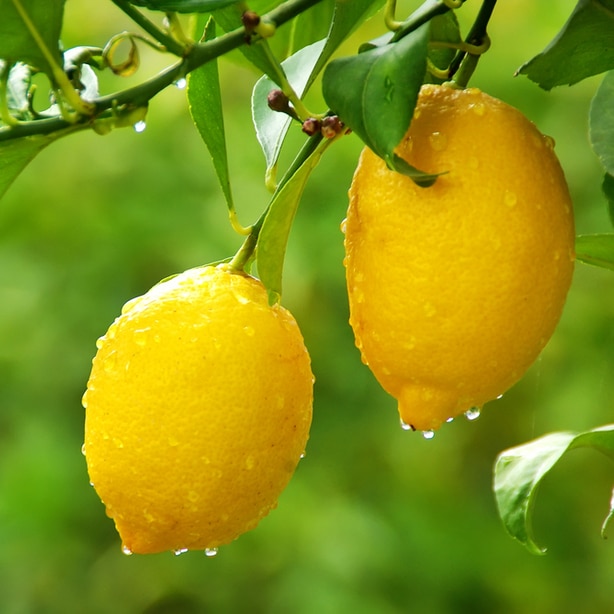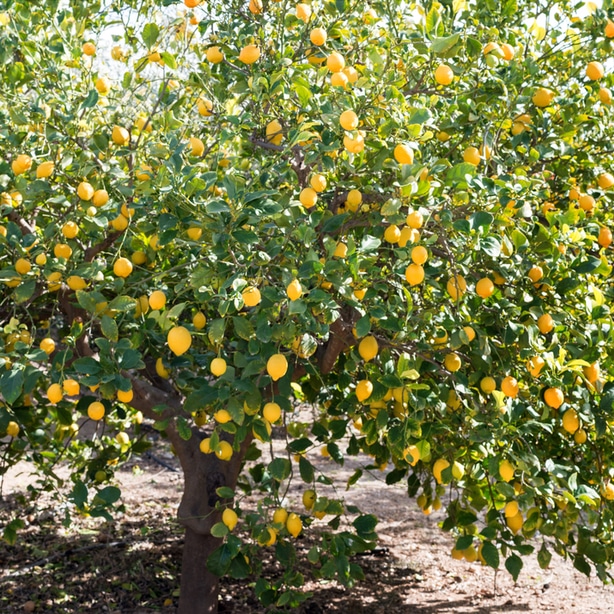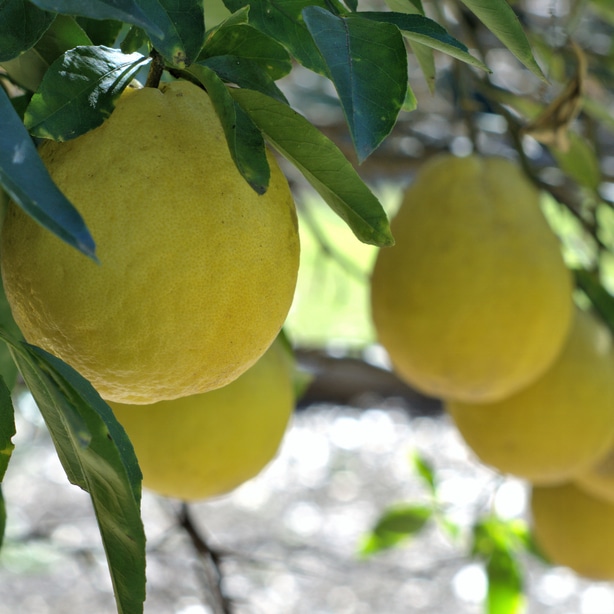With their fresh flavor and ease of growth, lemons are the perfect choice for gardeners wanting a bit of the tropics gracing their yards. Do you feel your climate is too cold? Don’t despair because of all citrus varieties’, lemons are the most cold-hardy and also thrive in pots.
Whether you want to grow the tree outdoors or in a pot, we give you all the information on how to grow a lemon tree. You’ll also learn how to provide it with proper care.
Continue reading and learn how to have a thriving tree producing years of bountiful harvests. You will probably end up with so many fruits you’ll be sharing them with everyone you know.

General Information
Most lemon trees (Citrus limon) are hardy growing outdoors in USDA zones 9 to 11. However, the Meyer variety is more cold-hardy, capable of growing as far north as zone 8. Those living in cooler climates can grow it in pots or indoors.
The evergreen produces robust growth that is open and spreading. If left unchecked, standard trees can grow up to 25 feet tall. Dwarf varieties suitable for pots typically grow up to 10 feet tall. You can keep its size-controlled through pruning.
A lemon tree is quite attractive, covered in its glossy green leaves. Depending on the variety, leaves can grow up to 4.5 inches long. While young, the leaves take on a reddish tint, changing to a solid green as it matures. Varieties can have thorns or be thornless.
In warm climates, red flower buds appear around November. In December through March, the highly fragrant flowers bloom. The blooms can fill the garden with their sweet fragrance. The flowers are white on top with purple undersides. A bonus of growing a lemon tree is you can have it bloom again in summer through fall. It’s perfectly normal for your trees to drop flowers before they form fruit, so don’t despair. All the flowers don’t get pollinated.
Of course, with a lemon tree, it’s all about the tangy citrus fruits. Depending on the rootstock, most are around two to three years old before they produce fruit. Three-year-old trees can produce up to 38 pounds of fruit yearly. However, once it reaches four years old, you can expect around 100 pounds yearly.
The shape of the fruit depends on the season it’s produced. The fruit produced during the months of summer and fall is mostly round. In contrast, the fruit produced during the months of winter through spring is more oval.

Depending on the variety, lemons can be a light yellow to bright yellow. Most contain seeds, although some cultivars are virtually seedless.
The size of the citrus fruit is also dependent on the climate. Lemons produced in warmer, subtropical areas are larger and contain more juice than those grown in cooler locales.
Climate conditions, variety, and cultural conditions all play a part when lemons are ready for harvesting. Bloom production to ripeness can take anywhere from four months to almost a year.
General Care Guide
Lemon trees thrive when given proper care. Although not as fussy as some citrus trees, they still require appropriate water, fertilization, and pruning. Like all types of citrus, their needs are more significant when newly planted and when flowering and fruiting. Proper care will result in a more abundant harvest of lemons for your year-round enjoyment.
Water Needs
Although not water hogs, it does requires regular irrigation during specific times of its growth. A newly planted lemon tree requires a good drenching immediately after planting. Water deeply, making sure you saturate the root ball.
Water every two to three days the first two weeks after planting. Then, cut back to once or twice weekly for the next two months while it establishes itself in the planting site. For the first two years, water periodically, especially when conditions are hot and dry.
Once it is established, it is relatively drought-tolerant but appreciates an occasional drink. Make sure to water them while they are flowering and fruiting. However, don’t water too often or keep the soil soggy to prevent disease problems.
When irrigating, keep the water off the foliage, flowers, and lemons to prevent problems with disease. Water early in the day so the moisture dries before nightfall.
When grown in containers, check the top several inches of soil for dryness. If dry, water until it flows from the bottom drain holes.

Mulch
Using a layer of mulch under the tree helps the soil retain moisture and cuts down on unwanted weed growth. Use a 2 to 6-inch layer of organic mulch spread evenly around the base.
To prevent trunk rot, keep the mulch pulled back at least 6 inches from the trunk.
Fertilizer Needs
Although the tree can be a little demanding with its fertilizer needs, don’t over-fertilize. Since your prime goal is a fruit-producing citrus tree, too much fertilizer leaves you with beautiful foliage at the expense of flowers and fruits.
The first feeding should take place when you start noticing new growth. For the first few years, fertilize every four months. Established trees only require feeding once or twice yearly.
You can find a good fertilizer for citrus trees at your local garden center. If you don’t see anything, using a product with a 6-6-6-2 analysis is sufficient. Follow label instruction on amounts.
Spread the fertilizer evenly under the tree’s canopy. Make sure you don’t butt the product against the tree trunk to prevent burning. After applying, water it into the soil and off any foliage it might have attached to.

Pruning Needs
Properly pruning a lemon tree controls its height, width, and the tree’s overall shape. Giving the tree light pruning throughout the growing season is best. However, you can prune off dead areas or water sprouts anytime throughout the year.
Keeping ground grown trees to a height of around 7 to 10 feet is best. This height makes harvesting the lemons easier. You can keep potted trees shorter, maintaining a height of about 4 to 6 feet.
The number of lemons produced during a season is reduced when the tree is heavily pruned. It’s better, and you won’t lose fruit if you do light trimmings as needed rather than one heavy pruning session.
Always use clean pruning tool blades when making your cuts. Just wipe the blades off with alcohol and you’re good to go. Otherwise, you might accidentally transfer a disease to the tree.
Frost Protection
If an unexpected freeze is threatening your locale, you’ll need to protect the lemon. You can protect trees in the landscape by hanging holiday lights through the canopy. You can also wrap it with sheets or burlap. Water the root system well before the cold snap as it helps insulate the roots keeping them warm.
Protect containers by bringing them indoors to a warm and bright location. If pots are too heavy, you can group them with other potted plants.

Varieties
Lemon varieties are classified in two ways: species and true lemons. True lemons include Femminello, Verna, and Sicilian types. Sicilian types are grown in the United States and include ‘Bears’ and ‘Lisbon.’ Two popular species and hybrids grown in the U.S. are ‘Meyer’ and ‘Ponderosa’ lemons. All have the same requirements for healthy growth.
‘Bears’ (Citrus limon ‘Bears’)
Classified as a true lemon, trees produce vigorous growth and usually don’t have thorns. It has a habit of producing a vast amount of water sprouts. The juicy, oblong fruit sports a prominent nipple. The outer skin is rough and yellow. The inner flesh is yellowish-green and contains few to no seeds. The juice is very acidic. “Bears’ is marketed for fresh fruit and making juice.
‘Lisbon’ (Citrus limon ‘Lisbon’)
Another true lemon growing into large thorny trees with a vigorous growth habit is ‘Lisbon.’ Densely foliated trees produce large quantities of fruit. It is a hardy selection, tolerating cold, heat, and windy conditions. The rough, yellow fruit has a moderately prominent nipple. The inner flesh is yellowish-green, juicy, and highly acidic. Fruit usually contains nine seeds or fewer.

‘Eureka’ (Citrus limon ‘Eureka’)
‘Eurekas’ are cold-sensitive and relatively short-lived citrus trees. They have a non-vigorous but spreading and open growth habit. It’s nearly thornless. Trees fruit year-round, with late winter through early summer being the main seasons. The smooth to slightly rough oblong fruit is yellow. It sports a moderate nipple. The lemon’s flesh is yellowish-green, very juicy, as well as acidic. Usually contains less than nine seeds. Fruits are marketed for fresh fruits.
Ponderosa (C. limon x C. medica)
Ponderosa lemon trees are thought to be a cross between a citron and lemon. The species hybrid started as a chance seedling found in the 1880s. Thorny trees are small compared to true lemons and are more cold-sensitive. Grapefruit-sized fruit is yellow with bumpy skin. The inner flesh is acidic, juicy, and seedy. They produce ripe fruit year-round.
Meyer Lemon (C. limon x C. reticulata)
Meyer trees are thought to be a cross between an orange and lemon. The hybrid species are smaller trees and are the perfect size for potted growth. Fruit production is almost year-round, with spring producing the best flowering. The tree is cold-hardy compared to many varieties. The fruit is medium-sized with a smooth, yellowish-orange skin. The yellowish-orange inner flesh is juicy, acidic, and seedy.

General Growing Tips
Growing a lemon tree in its preferred conditions is important to its long-term health and fruit production. It’s important to fulfill the tree’s site, sun, and soil requirements for best growth. Meeting its cultural needs and site requirements results in green, lavish trees. Happy trees produce an abundance of sweet-smelling flowers and fruit.
Site Selection
Selecting an appropriate site is very important to the long-term health of your tree. When selecting a site, there are several important factors you need to consider. You’ll want a place that large enough for the tree to grow naturally without interference. You’ll also need to consider how much light the area receives, soil, and overall conditions.
Consider your particular variety’s mature height and width. You want to select an area where the tree won’t interfere with structures or powerlines. It needs to be able to achieve its mature size without interference.
The area needs to be large enough for the tree to have good air circulation. This helps prevent pest and disease problems.
It’s also important to choose an area where water doesn’t puddle. Wet feet will result in trunk rot, which leads to death. This results in you being an unhappy gardener.
You also want to select the warmest area of your landscape to plant the tree. A location that is protected from strong winds is also advisable.
Sun Requirements
For the best performance, select a site that receives full sun exposure for six to eight hours per day. The tree won’t grow, flower or fruit well if the planting site is located in the shade. If growing the tree indoors, situate your tree in a location that receives bright sunlight. Place outdoor containers in a sunny area.
Turn indoor containers every few days to keep growth even. Otherwise, one side of the tree will reach toward the light.

Soil Requirements
Grow a lemon tree in well-drained soil. It’s not necessary to amend the native soil before planting. However, if you amend with organic matter, you need to mix it with the native earth before planting. If growing the tree in containers, use a potting mix that isn’t heavy and has good drainage.
If you decide to amend the native earth, use compost or well-rotted manure mixed into the native dirt you remove from the hole. Mix the organics into the soil at a ratio no larger than a 50-50 mix.
When growing in a pot, make sure the potting mix is lightweight and drains well. Heavy mixes retain too much water and can create problems with rot.
Planting Tips
Healthy growth starts the moment the lemon tree is planted. Whether growing it in the ground or a pot, proper planting is important. When planted and grown in preferred conditions, you prevent possible problems. You’ll only be making a sour face eating the lemons and not because it’s turned into a problem child in your landscape.
When planting in the landscape, dig a hole that is a bit deeper and wider than the container. This loosens the area making it easier for the roots to spread through the area.
If you plan on amending the area with organic material, now is the time to do the mixing. Mix the organics into the native soil excavated from the hole.
Place the root ball into the hole. Make sure it’s no deeper than it was originally growing in the container. Backfill the soil back into the hole, firming it up with your foot.
Planting on a Mound
If your desired area retains water or floods during heavy rain, you can plant on a mound. This lifts the root system out of the wet conditions. Pile the native soil up to create a mound that is about 3 to 4 feet tall and 4 to 10 feet in diameter.
Once you’ve created the mound, plant as usual. Just be sure that you do not plant any deeper than it was originally growing.
Planting in Pots
When planting in a pot, make sure it has bottom drainage holes. Otherwise, the soil doesn’t drain properly and problems with rot can occur. Any type of container works well. However, the soil dries quicker in unglazed terra cotta than in plastic. This means you’ll have to water more frequently, especially when conditions are hot and dry.

Whether growing the lemon tree indoors or outside, select a pot that is only one size larger than the present one. Soil stays wet too long in pots that are much larger than the root system. Plant the tree at the same depth it was growing in the original container.
To make moving the lemon easier, place the container on a rolling plant cart.


Hi Carley,
Can a standard grafted eureka lemon tree be maintained to max height of 6 ft in the ground? I would buy a dwarf but none available here in palm beach cty. Need to keep it short as the crows peck away at the lemons while they are still small and green. Thanks.